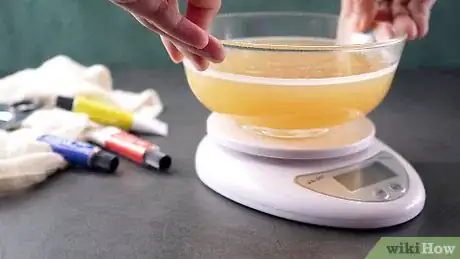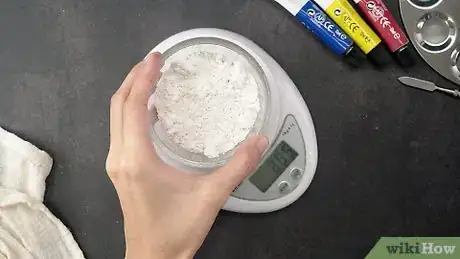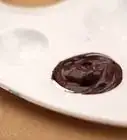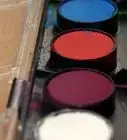This article was co-authored by wikiHow staff writer, Jessica Gibson. Jessica Gibson is a Writer and Editor who's been with wikiHow since 2014. After completing a year of art studies at the Emily Carr University in Vancouver, she graduated from Columbia College with a BA in History. Jessica also completed an MA in History from The University of Oregon in 2013.
There are 8 references cited in this article, which can be found at the bottom of the page.
The wikiHow Video Team also followed the article's instructions and verified that they work.
This article has been viewed 26,618 times.
Learn more...
If you've just run out of gesso before starting a painting, don't run to the store! You probably already have everything you need to make an acrylic gesso and mixing it up yourself will give you more control over how thick or white it is. Keep in mind that if you're priming an oil painting with gesso, you need to spend a little time preparing a traditional oil gesso. Once you have your oil or acrylic gesso, brush it evenly on the surface you want to paint and let it dry. The gesso will smooth your material and cover any imperfections so you have a truly blank canvas!
Ingredients
- 1 part acrylic polymer gloss medium
- 1 part titanium white acrylic paint
- 1 part whiting chalk or calcium carbonate dissolved in water
- 1/2 cup (70 g) of dried animal glue
- 4 cups (950 mL) of water
- 1 part whiting chalk or calcium carbonate
- Titanium white pigment, optional
Steps
Acrylic Gesso
-
1Dissolve whiting chalk in enough water to make a paste. Put whiting chalk or calcium carbonate into a container and slowly stir in a few drops of water. Keep stirring in more water until the chalk dissolves and forms a thin paste.[1]
- You can purchase whiting chalk from home improvement stores or online.
- If you want to make a small amount of gesso, try using about 1 tablespoon (8 g).
- If you prefer, you can mix a small amount of gesso directly on a paint palette using a palette knife.
Tip: If you don't have whiting chalk or calcium carbonate, finely grind a few sticks of white chalk.
-
2Squirt in equal parts of acrylic polymer gloss medium and white paint. Get out a bottle of acrylic polymer gloss medium and squeeze in about the same amount as your chalk paste. Then, squeeze in the same amount of titanium white acrylic paint.[2]
- You don't have to be exact in these ratios. For example, if you don't need the gesso to be very white, you could leave out the titanium white acrylic paint. If you want very white gesso, try adding 2 or 3 times as much white acrylic paint.
Advertisement -
3Mix the chalk paste with the paint and gloss medium until it's smooth. If you're mixing the gesso in a container, use a spoon or stirring rod to thoroughly combine the materials. If you're mixing the gesso directly on a palette, use your palette knife to mix them.[3]
- You shouldn't see any lumps of paint or gloss medium once you've finished mixing the gesso.
- The gesso should be the consistency of house paint once it's ready to use.
-
4Brush the gesso over your surface before you paint with acrylics. You can prime canvas, raw linen, cotton, paper, fiberboard, or wood. Leave the gesso to dry completely before brushing on additional coats. Each coat should dry for 10 to 20 minutes. Then, leave the material to dry for 12 hours before working on it with acrylics.[4]
- Avoid coating an old oil painting with acrylic gesso since it will peel or crack. If you'd like to paint over an old oil painting, cover it with oil gesso instead.
Tip: To store leftover acrylic gesso, cover the container tightly with a lid or plastic wrap and keep it at room temperature.
Traditional Oil Gesso
-
1Soak dried animal glue in water for at least 3 hours. Use 1/2 cup (70 g) of dried animal glue and 4 cups (950 mL) of water. Measure the dried glue and put it into a heat-proof bowl. Then, pour in the water and leave the mixture at room temperature for at least 3 hours so the glue swells.
- You can prepare the animal glue solution overnight if you prefer.
-
2Heat the glue solution in a double boiler until it reaches 140 °F (60 °C). Stir the solution occasionally as the glue dissolves and becomes slightly sticky and thick. It's important to turn off the burner before the solution boils or gets hotter than 140 °F (60 °C). You can use an instant-read thermometer to determine the temperature.
- The glue solution should look like thick chicken broth.
- If the solution boils, the gesso won't stick to your material very well.
Tip: To set up a double boiler, place a pot on the stove and pour in at least 2 inches (5.1 cm) of water. Bring the water to a gentle simmer over medium heat and place the bowl with the soaking glue into the pot. The bottom of the bowl shouldn't touch the simmering water.
-
3Let the glue solution cool and weigh it. Once you've turned off the burner, pour the hot solution into another heat-proof bowl and leave it at room temperature until it's just warm to the touch. Then, place the bowl on a scale and weigh your solution.[5]
- You'll need the weight of the solution to determine how much chalk and pigment to add.
-
4Weigh an equal amount of whiting chalk or calcium carbonate. Set another bowl that weighs as much as the bowl with the glue onto the scale. Continue to add whiting chalk or calcium carbonate to the bowl until it weighs the same as the glue solution.[6]
- You can buy whiting chalk at home improvement stores or online.
- In a pinch, you can finely grind sticks of chalk to use.
Variation: If you want your gesso to be even whiter, scoop out 1/2 of the chalk that you weighed and replace it with titanium white pigment.
-
5Stir the chalk into the solution until the gesso is smooth. Carefully pour the chalk or calcium carbonate you weighed into the glue solution and use a clean wooden spoon to stir it. Mix gently so you don't create air bubbles in the gesso.[7]
- The chalk should dissolve quickly in the glue solution and you shouldn't see any lumps.
-
6Stretch a stocking over a storage container and strain the gesso through it. Get out a clean storage container for your gesso and stretch a nylon stocking over the top. Then, slowly pour the gesso through the stocking to catch grit or impurities.[8]
- You can use your hands to squeeze the gesso through the stocking.
- To store the gesso, cover the storage container tightly. It should keep indefinitely at room temperature.
-
7Use the gesso to prime rigid materials before painting on them. Dip a paintbrush into your gesso and brush it evenly over your rigid material. You could spread the gesso on wooden panels or fiberboard, for instance. Let the gesso dry completely before adding extra coats. It should take about 20 minutes for each coat to dry.
- Let the primed surface dry for at least 24 hours before you begin oil painting on it.
Warnings
- Although you've probably seen gesso recipes using baking soda, these aren't recommended. The gesso may discolor or flake over time, which would damage your project.⧼thumbs_response⧽
- Avoid making gesso with baby powder or talc since these contain perfume and other additives that will cause the gesso to peel away from your material.⧼thumbs_response⧽
- You shouldn't use joint compound to make gesso since it usually contains talc, silica, and other additives.⧼thumbs_response⧽
Things You'll Need
Acrylic Gesso
- Storage container
- Spoon or stirring rod
Traditional Oil Gesso
- Heat-proof bowls
- Double boiler
- Instant-read thermometer
- Spoon
- Scale
- Stocking
References
- ↑ https://youtu.be/HpW34cqy57s?t=89
- ↑ https://youtu.be/HpW34cqy57s?t=126
- ↑ http://www.noteaccess.com/MATERIALS/AcrylicRG.htm
- ↑ https://emptyeasel.com/2007/06/29/how-to-prime-a-canvas-a-tutorial-on-priming-with-acrylic-gesso/
- ↑ https://youtu.be/1xHJ90Gx4B8?t=136
- ↑ https://youtu.be/1xHJ90Gx4B8?t=177
- ↑ https://youtu.be/1xHJ90Gx4B8?t=190
- ↑ https://youtu.be/1xHJ90Gx4B8?t=199
About This Article
If you don’t want to buy pre-mixed acrylic gesso, you can make your own with whiting chalk, acrylic polymer gloss medium, and titanium white acrylic paint. Put a few tablespoons of the whiting chalk in a bowl and mix it with water to create a paste. If you don’t have whiting chalk, you can make some by grinding white sticks of chalk into a fine powder. Mix the chalk paste with roughly equal amounts of the gloss medium and white paint to create your gesso. Brush the gesso onto your canvas or other painting surface and let it dry for 12 hours before you begin painting. For tips on how to make a traditional oil gesso, read on!
















































